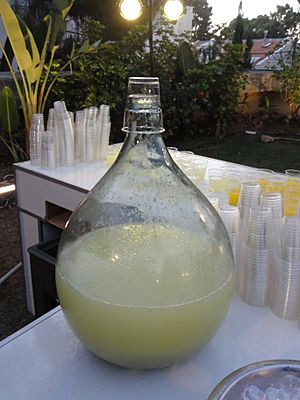Grapefruit juice facts for kids
Grapefruit juice is a yummy drink made from grapefruits. It's packed with vitamin C, which is great for your body! This juice can taste different depending on the type of grapefruit. Some are sweet and a little tart, while others are quite sour. You can find white, pink, and ruby red grapefruit juice.
Grapefruit juice is also important in medicine. It can change how some common medicines work in your body. This is why doctors sometimes tell people to avoid it when taking certain pills. It is a popular breakfast drink in places like the United States.
Grapefruit Juice in Drinks
Grapefruit juice is a great ingredient for many different kinds of drinks. It adds a fresh, tangy flavor.
For example, it's used in a drink called the "sea breeze." This drink mixes grapefruit juice with cranberry juice. Another popular one is the "salty dog." There's also a grapefruit "mimosa," which is a bubbly drink. Sometimes, it's even mixed with a light beer to make a "radler." These are just a few ways people enjoy grapefruit juice in fun beverages.
Quality Standards for Grapefruit Juice
In some countries, like Canada, there are rules about how grapefruit juice is made and sold. These rules help make sure the juice is good quality.
For example, the juice must come from clean, ripe grapefruits. Makers can add a little sugar or other sweeteners to it. They can also add special ingredients to keep it fresh. These rules help make sure you get a safe and tasty drink.
See also
 In Spanish: Jugo de pomelo para niños
In Spanish: Jugo de pomelo para niños



